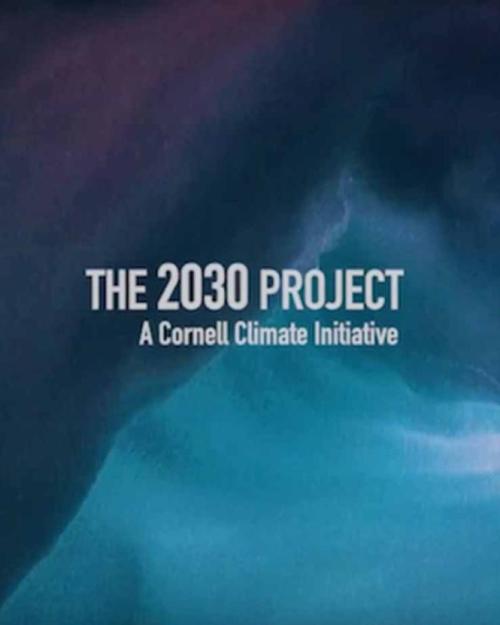To mitigate climate change, physicist David Specht, M.S. ’18, Ph.D. ’21, feeds electricity to microbes.
In turn, the insatiable Vibrio natriegens bacteria – the fastest duplicating organism on Earth, able to double itself in about 10 minutes – gorge on a sparky feast, but then the microbe can help scientists and farmers free up arable land, nourish livestock and feed farmed fish.
The V. natriegens endeavor is among the first “Moving Research to Impact” fast grants funded by the Cornell Atkinson Center for Sustainability as part of the 2030 Project: A Cornell Climate Initiative, which is mobilizing faculty to develop and accelerate tangible solutions to a warming world.
Grants were awarded on an array of climate solutions, including the development of advanced materials for carbon capture and solar panels, tools to help New York communities reduce their greenhouse gas emissions, recommendations for auto workers to navigate the workforce transition to electric vehicles, practices for reducing gas emissions in the dairy industry, and the creation of new textiles for cooling and energy efficiency.
“Climate change is a pressing challenge and we don’t have a moment to lose,” said Ben Furnas, executive director of the 2030 Project. “These grants are designed to get resources into the hands of Cornell’s world-class researchers quickly and to help them begin running projects that will make a difference. It’s just one way that the 2030 Project is mobilizing to do the greatest good in this decisive decade for climate action.”
The 2030 Project is accepting grant applications for the first round until Sept. 19.
In their V. natriegens project, Specht; Buz Barstow, assistant professor of biological and environmental engineering; and Sijin Li, assistant professor of chemical and biomolecular engineering, will construct a bioreactor device – they call it the OgRE, the On-the-fly Guide RNA-directed Evolution – that influences the quick development of V. natriegens in its electrically supported growth.
Such a microbial chassis, Specht said, will enable a myriad of applications that address climate change, including the replacement of agricultural inputs to produce carbon-neutral biofuels or animal feeds.
“We can use Vibrio natriegens in many ways,” Specht said. “Using renewable electricity to feed these microbes will help to reduce pressure on arable land to provide people with protein. We don’t have to cut down rainforests to feed growing populations.”
For this round, the remaining fast grants are:
- Robert Howarth, the David R. Atkinson Professor of Ecology and Environmental Biology, and Roxanne Marino, senior research associate in ecology and evolutionary biology, in the College of Agriculture and Life Sciences (CALS) will develop tools to assist local New York governments to consistently estimate greenhouse gas emissions, in accordance with the state’s Climate Leadership and Community Protection Act of 2019.
- Poppy McLeod, the Kenneth J. Bissett '89 Senior Professor and chair of Department of Communication; Tina Phillips, assistant director, Cornell Lab of Ornithology; Becca Rodomsky-Bish, project leader, Cornell Lab of Ornithology (CALS) will examine the climate impacts of lawn care. Emerging research suggests that talking with neighbors, friends and family members increases pro-environmental attitudes and can influence better lawn care practices.
- Chuan Liao, assistant professor in global development and Rebecca Nelson, professor of plant pathology and global development (CALS), will examine the potential for using organic, underutilized resources to advance the circular bionutrient economy to support a transition to zero-carbon agriculture.
- Jonathan Russell-Anelli, senior lecturer in soil and crop sciences (CALS) and Nelson will engage teams working in New York City and Ithaca on urban and peri-urban horticulture, aiming to advance the circular bionutrient economy. The grant will enable farmers, researchers and extension specialists to visit demonstration sites related to soil health innovations.
- Michael Van Amburgh, professor of animal science; and Dave Barbano, professor of food science (CALS) will explore climate impacts of the dairy industry, which is focused on methane reduction. Nitrous oxide that results from overfeeding protein to cattle is a potent greenhouse gas; the proposed research looks to reduce protein feeding.
- Ian Greer, research professor and director of the ILR Ithaca Co-Lab and Virginia Doellgast, professor of international and comparative labor (ILR School) will examine the manufacturing future of electric vehicles. As automakers phase out internal combustion engines and ramp up electric vehicle production, the team will explore the union, managerial and policy approaches to mitigate disruption to workers.
- Margaret Frey, the Vincent V. C. Woo Professor in Fiber Science and Apparel Design, and Heeju Park, associate professor of human centered design (College of Human Ecology), will create a textile incorporating structures at micro- and nanoscales to control the transmission of energy in the infrared spectrum. This textile could be incorporated as a very thin layer onto exterior surfaces, windows or clothing.
- Andrew Musser and Phillip Milner, both assistant professors of chemistry and chemical biology (College of Arts and Sciences), will develop a simple, scalable coating that can improve silicon solar cell efficiency by harnessing molecular material – crystalline nanocolloids – to capture energy generally wasted as heat.
- Brett Fors, associate professor of chemistry and chemical biology; Héctor Abruña, the Emile M. Chamot Professor of Chemistry; and Milner (A&S) will develop new materials for carbon dioxide capture from point sources to fight climate change. One of the major limitations of current technologies is the high energy costs required for carbon dioxide desorption. Here, the group proposes to develop a new class of adsorbents in which electricity – instead of heat or vacuum – can be used to recover carbon dioxide.
- Tristan Lambert, professor of chemistry and chemical biology (A&S), and Milner will develop new, highly reactive carbon-based molecules capable of direct-air-capture of carbon dioxide for the first time. The project will broaden the scope of carbon dioxide capture systems capable of achieving negative emissions.




